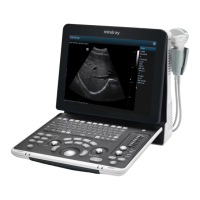Acoustic Output 15-5
15.7.2 Limits of Acoustic Output
In accordance with the FDA Track 3 requirements, the derating (or attenuated) approach was
incorporated into the FDA Acoustic Output Limits, as listed below. The maximum acoustic
output level from any transducer in any operating mode is expected to fall below these limits.
FDA Maximum Acoustic Output Limits for Track 3 (Attenuated Values)
Application
I
spta.3
(mW/cm
2
) I
sppa.3
(W/cm
2
)
Or
MI
Regions
(except eyes)
720 ≤ 190 ≤ 1.9
15.7.3 Differences between Actual and Displayed MI and
TI
In operation, the system will display to the operator the Acoustic Output Parameters Thermal
Index, TI, or Mechanical Index, MI (or sometimes both parameters simultaneously). These
parameters were developed as general indicators of risk from either thermal or mechanical
action of the ultrasound wave. They serve to indicate to the operator whether a particular
setting of the system increases or decreases the possibility of Thermal or Mechanical effect.
More specifically, they were designed to assist in the implementation of the ALARA principle.
As an operator changes a given system control, the potential effect of the change in output
will be indicated. However, the Thermal Index is not the same as temperature rise in the body,
for several reasons. First of all, in order to provide a single display index to you, a number of
simplifying assumptions had to be made. The biggest assumption was the use of the
attenuating formula described above, which is much lower than the actual value for most
tissues within the body. Scanning through muscle or organ tissue, for example, will produce
much higher attenuation than 0.3 dB/cm/MHz. There were also significant simplifications
made for the thermal properties of tissue. Therefore, scanning through highly perfused tissue,
such as the heart or vasculature, will produce significantly less thermal effect than that
suggested by the Thermal Index.
Similarly, the Mechanical Index was derived to indicate the relative possibility of mechanical
(cavitation) effects. The MI is based on the derated peak-rarefactional pressure and the center
frequency of the ultrasound wave. The actual peak-rarefactional pressure is affected by the
actual attenuation caused by tissue in the path between the transducer and the focal point.
Again, all solid tissues within the body have higher attenuation than the proscribed 0.3
dB/cm/MHz value, and therefore, the actual peak-rarefactional pressure will be lower. Further,
the actual peak-rarefactional pressure will change depending upon the region of the body
being scanned.
For these reasons, the TI and MI displays should only be used to assist the operator in
implementing ALARA at the time of the patient examination.

